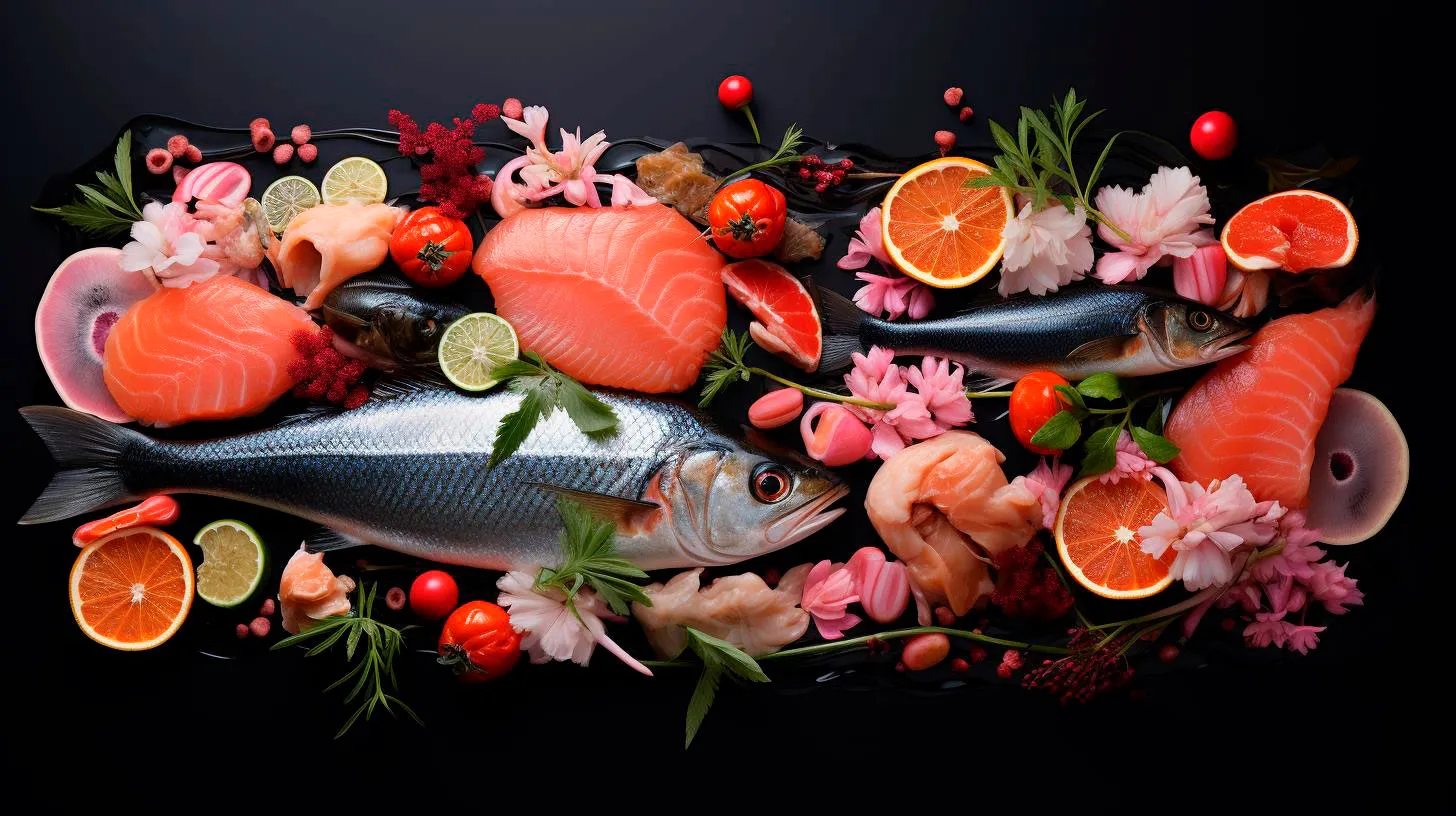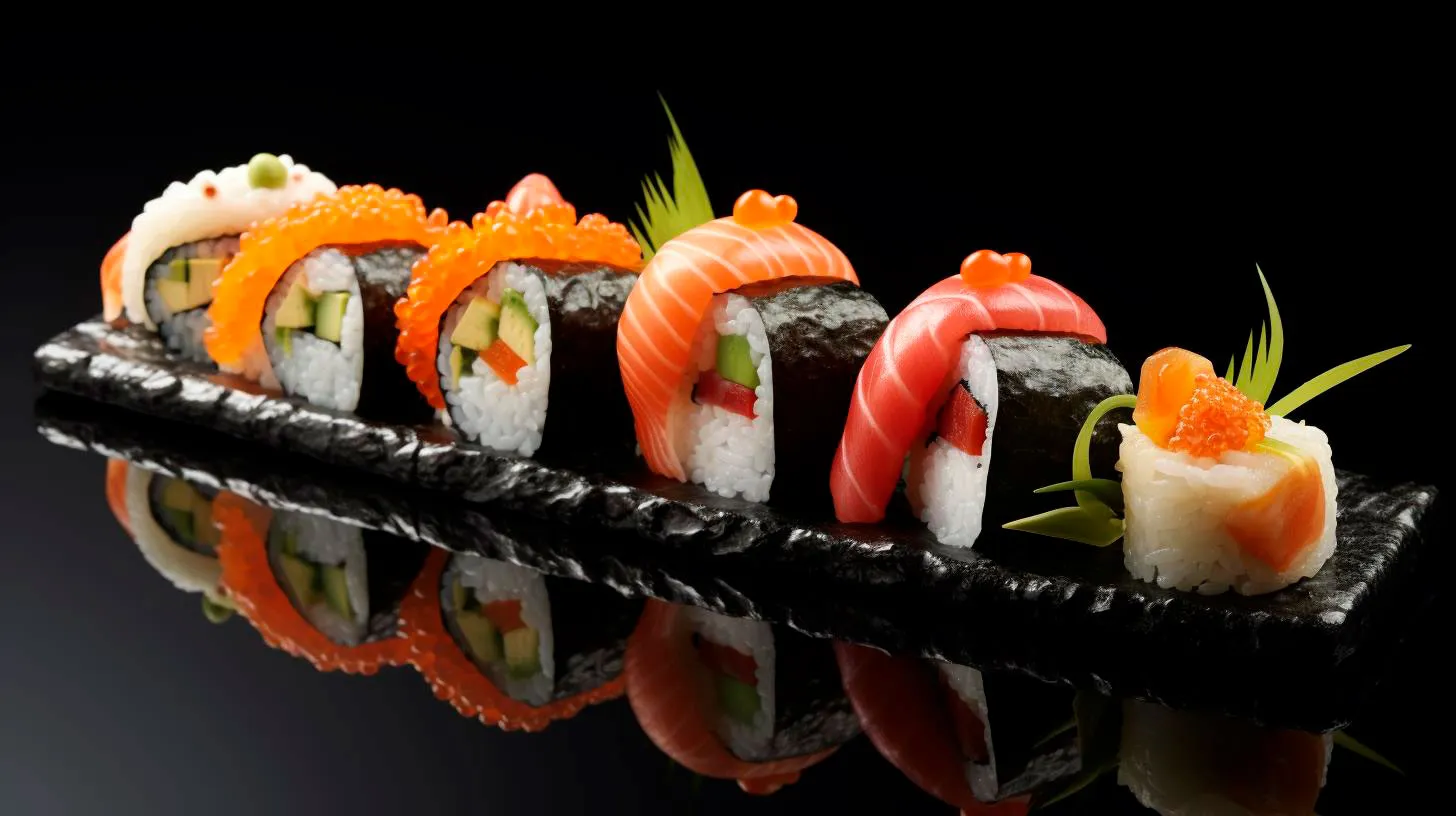Unveiling the Secrets of Sushi: Discover the History and Traditions Behind this Ancient Dish
In this article, we will delve into the history, traditions, and key aspects of sushi, revealing the secrets behind its enduring popularity.
The Origins of Sushi
The exact origins of sushi can be traced back thousands of years to China, where preserved fish was first fermented with rice. This ancient preservation method was introduced to Japan around the 8th century AD, and over time, the Japanese developed their own unique style of sushi. It was during the Edo period (1603-1868), that sushi emerged as a widespread and popular dish served in the streets of Tokyo.
Today, sushi has evolved into a diverse and sophisticated culinary art form, showcasing the creativity and skill of sushi chefs worldwide. Its popularity has skyrocketed, with sushi restaurants spanning across the globe, catering to the cravings of millions.
The Art of Sushi Making
Sushi making is an art that requires precision, attention to detail, and years of practice to master. Sushi chefs, known as Itamae, meticulously select the freshest ingredients and carefully prepare each sushi roll with finesse. One of the hallmarks of sushi is the chef’s ability to balance flavors, textures, and colors, resulting in a harmonious and visually appealing dish.
A key component of sushi is the vinegared rice, known as shari. It is cooked to perfection and seasoned with a unique blend of rice vinegar, salt, and sugar. The selection of fish for sushi is crucial, with popular options including tuna, salmon, and shrimp. Vegetarian sushi varieties, such as avocado or cucumber rolls, are also widely enjoyed.
Aside from the traditional sushi rolls, there are other variations like nigiri, which is a small mound of rice topped with a slice of fresh fish or seafood. Another popular type is sashimi, which consists of thinly sliced raw fish, often served with soy sauce and wasabi for dipping.
The Influence of Tradition
Sushi is deeply rooted in Japanese culture, and many customs and traditions surround its consumption. Here are some key aspects:
- Omakase: A traditional dining experience where the chef selects and prepares a series of sushi dishes based on the freshest ingredients available.
- Wasabi and Soy Sauce: Wasabi, a pungent green paste, is used sparingly on sushi to add a spicy kick, while soy sauce is typically used as a dipping sauce. However, it’s important to exercise moderation to preserve the delicate flavors of the sushi.
- Ginger: Pickled ginger, or gari, is often served alongside sushi as a palate cleanser between different rolls.
The Health Benefits of Sushi
Beyond its incredible flavors and cultural significance, sushi also offers several health benefits:
- Omega-3 Fatty Acids: Fish like salmon and tuna used in sushi are excellent sources of omega-3 fatty acids, which are known to promote heart health and reduce inflammation.
- Low in Calories: Sushi rolls, particularly those with lean fish and vegetable fillings, are relatively low in calories, making them a healthy option for those watching their weight.
- Rich in Minerals: Sushi contains essential minerals like iodine and selenium, which play a vital role in metabolism and overall well-being.
Key Takeaways
Sushi is a gastronomic delight that combines history, tradition, and exquisite flavors into every bite. Here are the key takeaways from our exploration:
- Sushi originated thousands of years ago and has evolved into a global culinary sensation.
- The art of sushi making requires skill, precision, and a keen eye for balancing flavors.
- Traditions surrounding sushi consumption, such as omakase and the use of wasabi and ginger, add to the cultural experience.
- Sushi offers numerous health benefits, including omega-3 fatty acids and essential minerals.
So, the next time you indulge in a plate of sushi, take a moment to appreciate the centuries-old traditions and craftsmanship that went into creating this exquisite delicacy. Savor each bite and immerse yourself in the fascinating world of sushi.
From Sushi Rolls to Sashimi: Exploring the Diversity of Japanese Cuisine
The Art of Sushi
Sushi is undoubtedly one of Japan’s most renowned culinary creations. A delicate combination of vinegared rice, fresh seafood, and vegetables, sushi offers a myriad of flavors and textures that appeal to food enthusiasts everywhere. Here are some key takeaways on this beloved dish:
- Sushi rolls, also known as maki, are the most familiar form of sushi. They typically consist of rice and fillings such as fish, vegetables, or even tropical fruits, all encased in a sheet of seaweed.
- Nigiri sushi, on the other hand, features a small mound of vinegared rice topped with a thin slice of fresh fish or seafood. This style showcases the natural flavors and textures of the ingredients.
- Japanese sushi chefs dedicate years to perfecting the art of sushi-making, ensuring the utmost precision in every roll. The presentation is just as important as the taste, with the visual aspect playing a significant role in the overall experience.
- Sushi is not only a delightful feast for the senses but also a healthy choice. It is low in calories, high in omega-3 fatty acids, and packed with essential nutrients like vitamins A, B, and D.
The Elegance of Sashimi
While sushi has become a global sensation, sashimi holds its own special place in Japanese cuisine. Unlike sushi, sashimi refers to thin slices of raw fish or seafood served without rice. Let’s explore the alluring qualities of sashimi:
- Sashimi showcases the pure essence of the ingredients used, placing emphasis on the quality and freshness of the fish or seafood. The delicate cuts and minimal seasoning allow for an authentic and unadulterated experience.
- Common types of sashimi include maguro (tuna), sake (salmon), hamachi (yellowtail), and tako (octopus). Each type offers a unique taste profile and texture, appealing to a wide range of preferences.
- Traditionally, sashimi is served with soy sauce, wasabi, and pickled ginger. These accompaniments enhance the flavors without overpowering the natural taste of the fish or seafood.
- Sashimi is a prime choice for those seeking a low-carb and high-protein option. The lean cuts of fish provide essential nutrients while keeping calorie intake in check.
Embracing Tradition
Japanese cuisine prides itself on its connection to tradition and the respect shown to its culinary heritage. Here are some intriguing insights into the cultural significance of Japanese food:
- The preparation and presentation of Japanese food are deeply rooted in the country’s traditional customs. Every dish is meticulously crafted to offer both visual and gastronomic pleasure.
- Japan has the highest number of Michelin-starred restaurants in the world, with many of them specializing in traditional Japanese cuisine. The country’s dedication to excellence and attention to detail are highly regarded in the culinary realm.
- Washoku, the traditional dietary culture of Japan, was recognized as an Intangible Cultural Heritage by UNESCO in 2013. This acknowledgment highlights the importance of preserving and promoting the country’s unique food traditions.
- Japanese cuisine’s focus on fresh, seasonal ingredients not only ensures optimal taste but also supports sustainability. Japan’s fishing industry is known for its commitment to responsible fishing practices, helping conserve marine ecosystems.
Final Thoughts
From sushi rolls to sashimi, Japanese cuisine offers a diverse range of flavors, textures, and cultural experiences. Whether you are a sushi enthusiast or intrigued by the elegance of sashimi, exploring the myriad dishes of Japan is a journey worth embarking on. So, venture into the world of Japanese cuisine and tantalize your taste buds with the artistry and flavors of this esteemed gastronomic tradition.
The Art of Sushi Making: A Delicate Culinary Craft
In this article, we will explore the fascinating world of sushi making, its history, ingredients, and the delicate craft behind its creation.
A Brief History of Sushi
The origins of sushi can be traced back to 7th century Japan, where it was consumed as fermented fish preserved with rice. Over time, sushi evolved, and during the Edo period (17th-19th century), it transformed into the beloved dish we recognize today. Initially, sushi was a street food, but it later gained prominence as a delicacy in high-end restaurants.
The techniques and traditions of sushi making were carefully preserved and refined, passed down from generation to generation. Today, sushi is not only a reflection of Japanese culture but also a global culinary phenomenon.
The Art of Sushi Making
Sushi making is a meticulous craft that demands dedication and expertise. Skilled sushi chefs, known as Itamae, undergo years of training to perfect their techniques. From selecting the finest ingredients to the intricate process of assembling the sushi, every step is carried out with utmost care and precision.
Let’s delve into the key aspects that make sushi making an art:
1. Knife Skills
The precise cutting techniques employed by sushi chefs are vital in creating visually appealing and perfectly proportioned sushi pieces. The sharpness of their knives is considered crucial to achieve clean cuts and maintain the integrity of the ingredients.
2. Rice Preparation
The quality of sushi rice greatly impacts the overall taste and texture of the dish. It requires thorough rinsing, cooking, and seasoning with vinegar, salt, and sugar. Achieving the right balance is essential for creating sushi rice with the perfect stickiness and flavor.
3. Ingredient Selection
The selection of ingredients is crucial in sushi making. The freshness and quality of seafood, such as tuna, salmon, and shrimp, are of utmost importance. Additionally, the choice of vegetables, like cucumber and avocado, can enhance the flavor and create a harmonious balance in each sushi roll.
4. Assembly Techniques
Properly assembling sushi rolls requires manual dexterity and an understanding of the ingredients’ characteristics. Whether it’s the classic maki roll, nigiri, or sashimi, sushi chefs carefully layer ingredients to create aesthetically pleasing and flavorful combinations.
The Advantages of Sushi Making
Sushi making is not just an art form but also offers several advantages:
- Health Benefits: Sushi is known for its nutritional value, with options that are low in calories and high in omega-3 fatty acids and antioxidants.
- Cultural Experience: Learning how to make sushi provides insight into Japanese culture, offering a unique connection to its traditions and customs.
- Creativity and Customization: Sushi making allows for experimentation and customization, where individuals can explore a variety of fillings, rolls, and flavor combinations.
- Social Engagement: Sushi making can be a social activity, bringing friends, family, or colleagues together for an interactive and enjoyable culinary experience.
Intricate, Flavorful, and Beautiful
Sushi making is a delicate culinary craft that blends exquisite flavors, meticulous techniques, and beautiful presentation. As you indulge in these bite-sized morsels of edible art, remember the centuries of tradition and craftsmanship that go into each piece.
The art of sushi making continues to evolve, with innovative twists and fusion creations expanding its possibilities. Whether you are a sushi enthusiast or an aspiring chef, exploring the art of sushi making will undoubtedly deepen your appreciation for this beloved cuisine.
Health Benefits of Sushi: Nourish Your Body with Fresh Seafood
Let’s dive into the health benefits of this delectable dish and understand why it has become a favorite among health-conscious individuals.
1. High-Quality Protein Source
Sushi is primarily made with raw fish, such as tuna, salmon, or mackerel. These fish are loaded with high-quality proteins, which are vital for muscle growth, tissue repair, and overall body development. Consuming protein-rich sushi can assist in maintaining a healthy body weight and promoting satiety, which makes it an ideal choice for those looking to shed extra pounds.
Key Takeaway: Sushi is an excellent source of high-quality protein, which aids in muscle growth, tissue repair, and weight management.
2. Omega-3 Fatty Acids for Heart Health
Fish used in sushi, especially salmon, is abundant in omega-3 fatty acids. These essential fatty acids play a crucial role in reducing the risk of heart disease, lowering blood pressure, and maintaining healthy cholesterol levels. Regular consumption of sushi can contribute to a healthy cardiovascular system.
Key Takeaway: Sushi’s omega-3 fatty acids are beneficial for heart health, reducing the risk of heart disease, and promoting healthy cholesterol levels.
3. Rich in Vitamins and Minerals
Sushi contains a wide range of ingredients, including seaweed, vegetables, and pickled ginger. These ingredients offer a plethora of essential vitamins and minerals. Seaweed, often used to wrap sushi rolls, is an excellent source of iodine, which is vital for maintaining a healthy thyroid gland. Additionally, sushi often incorporates a variety of vegetables, such as cucumber and avocado, which provide an array of vitamins like vitamin C, E, and K.
Key Takeaway: Sushi’s diverse ingredients provide essential vitamins and minerals, including iodine from seaweed and various vitamins from vegetables.
4. Low in Calories, High in Fiber
Sushi can be a great option for those seeking a low-calorie meal. By choosing sushi rolls with lean fish or vegetable fillings and avoiding fried options, you can enjoy a satisfying meal without excessive calorie consumption. Additionally, sushi often includes fiber-rich ingredients such as vegetables and whole grains. Fiber aids in digestion, promotes satiety, and helps maintain a healthy weight.
Key Takeaway: Sushi, when prepared with lean fish and vegetables, is a low-calorie option that provides fiber, aiding digestion and weight management.
5. Boosts Brain Health
The omega-3 fatty acids found abundantly in sushi promote brain health and functionality. DHA, a type of omega-3 fatty acid, is essential for brain development and functioning. Regular consumption of sushi, particularly fish like salmon or tuna, can enhance cognitive function and reduce the risk of cognitive decline.
Key Takeaway: Sushi’s omega-3 fatty acids improve brain health and can enhance cognitive function over time.
Conclusion
Sushi offers a delightful culinary experience while providing numerous health benefits. With its high-quality protein content, omega-3 fatty acids, essential vitamins and minerals, low-calorie nature, and brain-boosting properties, sushi stands out as a nutritious option for any health-conscious individual. So, the next time you’re at a sushi restaurant or preparing your own sushi at home, relish every bite while knowing that you’re nourishing your body.
Key Takeaway: Sushi combines culinary pleasure with a range of health benefits, making it a wise choice for individuals focused on their wellbeing.



